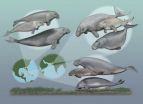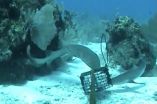(Press-News.org) Sirenians, or seacows, are a group of marine mammals that include manatees and dugongs; today, only one species of seacow is found in each world region. Smithsonian scientists have discovered that this was not always the case. According to the fossil record of these marine mammals, which dates back 50 million years ago, it was more common to find three, or possibly more, different species of seacows living together at one time. This suggests that the environment and food sources for ancient seacows were also different than today. The team's findings are published in the journal PLoS ONE.
Today there are only four species of seacows―three species of manatees, which are found in different coastal waters of the Atlantic Ocean, and one species of dugong, found along the coasts of the Indo-Pacific Ocean. All seacows are herbivores, and their diet is made up largely of seagrasses.
"The discovery that these multispecies seacow communities once existed revealed answers, but it also created new questions," said Nicholas Pyenson, curator of fossil marine mammals at the Smithsonian's National Museum of Natural History and co-author of the research. "Were these species competing against each other for seagrass resources, or were they avoiding competition by each species feeding in separate areas or on different grasses? Also, were seagrass beds structured differently in the past, or were they dominated by one seagrass species like we see today?"
To answer these questions, the team, lead by Smithsonian predoctoral fellow Jorge Velez-Juarbe, examined three localities from separate time periods, from the late Oligocene (about 23-28 million year ago) in Florida, the early Miocene (about 16-23 million years ago) in India and the early Pliocene (about 3-5 million years ago) in Mexico. All three areas showed conclusive fossil evidence that two or more species of seacow had once coexisted there.
By examining the size and dimensions of the skulls as well as estimating the body sizes, the team deduced that the different species of seacows had characteristics that allowed each to feed on different types of seagrass. Such separation among physical features, the team suggests, reduced any competition for food and allowed multiple species of seacows to coexist. This also suggests that, unlike today's seacow habitats that are dominated by one or two species of seagrass, many species of seagrass once coexisted.
INFORMATION:
Smithsonian scientists discover that multiple species of seacows once coexisted
2012-03-12
ELSE PRESS RELEASES FROM THIS DATE:
Avis Israel Offers Unique "On Demand" Car Rental Program for Evenings and Weekends
2012-03-12
Based on successful consumer research conducted through Facebook advertising, Avis Israel has launched its new "On Demand" car rental program. On Demand offers flexible and convenient access to short-term car rentals, without having to register or schedule ahead of time.
Focused on younger, urban drivers who would usually use public transportation or borrow a parents' vehicle, the On Demand program provides an attractive option. Drivers can now rent a car for short periods, ranging in time from only one hour up through a long weekend of Thursday afternoon ...
Radiation oncologists are discussing infertility risks with young cancer patients
2012-03-12
More than 80 percent of radiation oncologists discuss the impact of cancer treatments on fertility with their patients of childbearing age, which can lead to improved quality of life for young cancer patients who are living much longer after their original diagnosis thanks to modern treatment options, according to a study in Practical Radiation Oncology (PRO), the official clinical practice journal of the American Society for Radiation Oncology (ASTRO).
In the past, the clinical focus for young cancer patients was strictly survival. With the success of today's treatment ...
New pig model may lead to progress in treating debilitating eye disease
2012-03-12
LOUISVILLE, Ky. – A newly developed, genetically modified pig may hold the keys to the development of improved treatments and possibly even a cure for retinitis pigmentosa (RP), the most common inherited retinal disease in the United States. The pig model was developed by researchers in the University of Louisville Department of Ophthalmology & Visual Sciences and at the National Swine Resource and Research Center at the University of Missouri.
"We have previously relied mostly on rodent models to study the development and progression of this disease, and although very ...
Teach your robot well (Georgia Tech shows how)
2012-03-12
Within a decade, personal robots could become as common in U.S. homes as any other major appliance, and many if not most of these machines will be able to perform innumerable tasks not explicitly imagined by their manufacturers. This opens up a wider world of personal robotics, in which machines are doing anything their owners can program them to do—without actually being programmers.
Laying some helpful groundwork for this world is, a new study by researchers in Georgia Tech's Center for Robotics & Intelligent Machines (RIM), who have identified the types of questions ...
'Chum cam' underwater video survey shows that reef sharks thrive in marine reserves
2012-03-12
STONY BROOK, NY -- A team of scientists, led by the Institute for Ocean Conservation Science at Stony Brook University, used video cameras to count Caribbean reef sharks (Carcharhinus perezi) inside and outside marine reserves on the Mesoamerican Barrier Reef in the Caribbean Sea. Using survey data collected from 200 baited remote underwater video (BRUV) cameras, nicknamed "chum cams," the scientists compared the relative abundance of these reef sharks in two marine reserves with those in two areas where fishing is allowed, and demonstrated that the sharks were more abundant ...
OzeVision Web Hosting Nabs Two Web Hosting Awards In February 2012
2012-03-12
OzeVision Web Hosting repeats history by nabbing 15th position amongst the "Top 25 Most Poplar" web hosting companies in the category "Australian Web Hosting Directory" by WebHostDir.com and 7th position in the category "Australian Dedicated Servers Directory" by DedicatedServerDir.com for the month of February 2012. The awards pages can be viewed at:
http://ozevision.com/web_hosting/top-25-most-popular-webhosting-awards.html
http://ozevision.com/web_hosting/top-25-most-popular-dedicated-awards.html
Every month WebHostDir.com and DedicatedServerDir.com ...
Study pinpoints effects of different doses of an ADHD drug; Finds higher doses may harm learning
2012-03-12
MADISON – New research with monkeys sheds light on how the drug methylphenidate may affect learning and memory in children with attention deficit hyperactivity disorder.
The results parallel a 1977 finding that a low dose of the drug boosted cognitive performance of children with ADHD, but a higher dose that reduced their hyperactivity also impaired their performance on a memory test.
"Many people were intrigued by that result, but their attempts to repeat the study did not yield clear-cut results," says Luis Populin, an associate professor of neuroscience at the University ...
Drug helps purge hidden HIV virus, study shows
2012-03-12
CHAPEL HILL, N.C. -- A team of researchers at the University of North Carolina at Chapel Hill have successfully flushed latent HIV infection from hiding, with a drug used to treat certain types of lymphoma.
Tackling latent HIV in the immune system is critical to finding a cure for AIDS.
The results were presented today at the 19th Conference on Retroviruses and Opportunistic Infections in Seattle, Washington.
While current antiretroviral therapies can very effectively control virus levels, they can never fully eliminate the virus from the cells and tissues it has ...
New discovery shines light on the 3 faces of neutrinos
2012-03-12
A new discovery provides a crucial key to understanding how neutrinos – ghostly particles with multiple personalities – change identity and may help shed light on why matter exists in the universe.
In an announcement today (Thursday, March 8), members of the large international Daya Bay collaboration reported the last of three measurements that describe how the three types, or flavors, of neutrinos blend with one another, providing an explanation for their spooky morphing from one flavor to another, a phenomenon called neutrino oscillation.
The measurement makes possible ...
First findings released from Swaziland HIV incidence measurement survey announced at CROI 2012
2012-03-12
Seattle, Washington - The first findings from a nationally representative HIV survey were presented today at the 19th Conference on Retroviruses and Opportunistic Infections (CROI 2012) in Seattle, WA. The Swaziland HIV Incidence Measurement Survey (SHIMS) found that overall HIV prevalence, or percentage of the population living with HIV infection, is 31% among adults ages 18-49. This figure matches the 2006 Demographic Health Survey findings for the same age group, indicating that the HIV epidemic in Swaziland has stabilized over the past five years.
"The country continues ...





